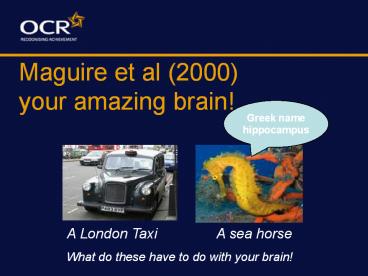Maguire et al (2000) your amazing brain! - PowerPoint PPT Presentation
1 / 24
Title:
Maguire et al (2000) your amazing brain!
Description:
Greek name hippocampus Maguire et al (2000) your amazing brain! A London Taxi A sea horse What do these have to do with your brain! – PowerPoint PPT presentation
Number of Views:37
Avg rating:3.0/5.0
Title: Maguire et al (2000) your amazing brain!
1
Maguire et al (2000) your amazing brain!
A London Taxi A sea horse What do
these have to do with your brain!
2
Maguire et al (2000) your amazing brain!
Navigation related structural change in the
hippocampi of London taxi drivers
Interesting Question Does the structure of your
brain change in response to environmental demand
3
Maguire et al (2000) your amazing brain!
- Where in the brain is the hippocampus
What does the hippocampus do? The role of the
hippocampus is to facilitate spatial memory
(navigation)
4
Maguire et al (2000) your amazing brain!
- Where in the brain is the hippocampus
Why HIPPOCAMPI? Each hemisphere of the brain has
a hippocampus hippocampi means TWO
5
Maguire et al (2000) your amazing brain!
- Research Question Can changes in the brain be
detected in those with extensive navigation
experience ? - The hypothesis
- That the hippocampi in London Taxi drivers will
be structurally different to the hippocampi in
non-taxi drivers
6
Maguire et al (2000) your amazing brain
- London Taxi Drivers On the knowledge
- It takes two years to train to become a London
Taxi driver - Must memorise thousands of routes
- Tested by police before a license issued
7
Maguire et al (2000)
- Method Natural experiment
- 2 groups of participants (their brain)
- IV London Taxi driver brain
- Non taxi driver brain
- DV structure volume of hippocampi
- Comparison of analysis of MRI scans
8
Maguire et al (2000)
- Participants
- 16 right handed, male, taxi drivers
- average age 44, all licensed more than 18 months,
average time as taxi driver 14.3 years - 16 right handed, male, age matched, non taxi
drivers
9
Maguire et al (2000)
- How was it done? The procedure
- MRI scans of brains of 50 healthy, right handed,
male, non taxi drivers aged 33 - 61 were analysed
to establish a comparison data base of average
hippocampi - analysis by Voxel Based Morphometry (VBM)
10
Maguire et al (2000)
- The procedure
- MRI scans of brains of 16 taxi drivers and of 16
matched controls were analysed by VBM and
compared to the data base of images - CONTROL the expert conducting the analysis did
not know whether MRI scan was taxi driver brain
or not
11
Maguire et al (2000)
- Findings (1)
- increased volume of grey matter in both the right
left hippocampi in taxi driver brains
12
Maguire et al (2000)
LH left hemisphere RH Right hemisphere
13
Maguire et al (2000)
- Findings (2) Correlational analysis
- Variable 1 length of time as taxi driver
- Variable 2 Right posteria hippocampus
- volume of right posteria hippocampus increased as
length of time as taxi driver increased
14
Maguire et al (2000)
- Findings (2) Correlational analysis
15
Maguire et al (2000)
- Findings (3)
- taxi drivers had greater volume in the posteria
hippocampus but non taxi drivers had greater
volume in the anterior hippocampus - indicating REDISTRIBUTION of grey matter in
hippocampus
16
Maguire et al (2000)
- Conclusion
- That the structure of the brain changes in
response to environmental demand - Conclusion
- That the mental map of the city of London is
stored in the posteria hippocampi
17
Maguire et al (2000)
- Is this useful?
- The evidence that normal activity can induce
changes in the structure of the brain, and in the
volume of grey matter, has many implications for
rehabilitation after brain injury
18
Maguire et al (2000) Ecological Validity?
- Is the way the experiment measures the DV (brain
structure) - and the experimental setting
- and the sample of participants realistic in a
real life setting? - Discuss why or why not?
19
Maguire et al (2000) Types of datadiscuss
strengths limitations
- Quantitative matters of fact objective,
scientific replicable - useful for analysis comparison
- or
- Qualitative matters of opinion
- subjective, rich in detail, can be hard to
analyse, may be misinterpreted
20
Maguire et al (2000) The experimental methodology
- Was the method appropriate for the aim?
- Are the experimental conditions realistic
(mundane realism real world realism) - How was the DV operationalised and was this a
valid measure of the behaviour being studied?
21
Maguire et al (2000) The experimental procedure
- How were the participants allocated to the
conditions and were controls used to remove
extra variables ? - Were there any cues that might have generated
demand characteristics ? - RELIABILITY Could the study be replicated to
find the same results? Why or why not?
22
Maguire et al (2000) The sample
- Who were the participants
- Was the sample biased in any way?
- Was the sample large enough to mask the effect of
individual differences? - To which population can we safely generalise the
findings?
23
Maguire et al (2000)
Psychology!!! Brains, taxis, sea horses The
MOST interesting science
24
(No Transcript)

